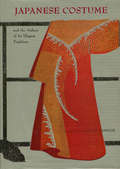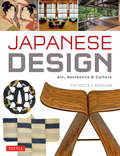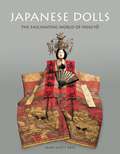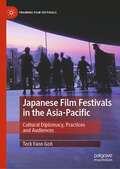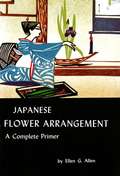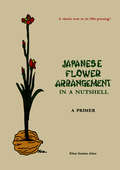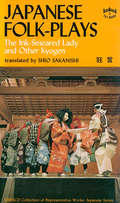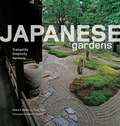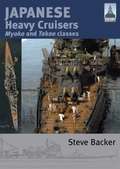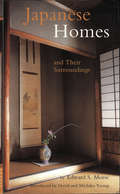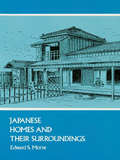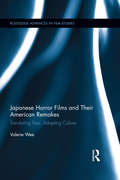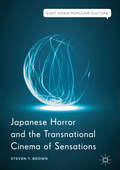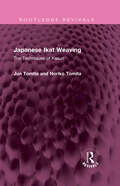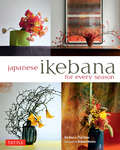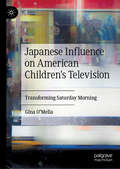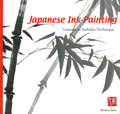- Table View
- List View
Japanese Costume: And the Makers of Its Elegant Tradition
by Shojiro Nomura Helen Benton MinnichWith dozens of photographs and expertly written text, this Japanese clothing book is the authoritative guide on the kimono.<P><P>Japanese Costume invites the reader to explore the world of Japan's textile arts and costume decoration-from its origins in legendary times, through its brilliant development in the intervening centuries, to its emergence into the modern era. The book which is the first in English to present the full sweep of Japanese achievement in the costume arts, is essential the story of the kimono and its evolution.The text is accompanied by a generous selection of fine illustrations and photographs: 54 in full color, 119 in black and white, and 12 line drawings. They include not only pictures from contemporary sources-such as the picture scrolls and woodblock prints- but also photographs of kimono masterpieces and representative textiles.
Japanese Design
by Patricia J. GrahamWhat exactly is the singular attraction of Japanese design? And why does it speak so clearly to so many people all over the world? The Japanese sensibility often possesses an intuitive, emotional appeal, whether it's a silk kimono, a carefully raked garden path, an architectural marvel, a teapot, or a contemporary work of art. This allure has come to permeate the entire culture of Japan-it is manifest in the most mundane utensil and snack food packaging, as well as in Japanese architecture, and fine art. In Japanese Design, Asian art expert and author Patricia J. Graham explains how this aesthetic based in fine craftsmanship and simplicity developed. Her unusual, full-color presentation reveals the Japanese design aesthetic in an absorbing way, using a combination of insightful explanations and more than 160 stunning photos. Focusing upon ten elements of Japanese design, Graham explores how visual qualities, the cultural parameters and the Japanese religious traditions of Buddhism and Shinto have impacted the appearance of its arts. Japanese Design is a handbook for the millions of us who have felt the special allure of Japanese culture, crafts, and art. Art and design fans and professionals have been clamoring for this-a book that fills the need for an intelligent, culture-rich overview of what Japanese design is and means.
Japanese Design
by Patricia J. GrahamWhat exactly is the singular attraction of Japanese design? And why does it speak so clearly to so many people all over the world? The Japanese sensibility often possesses an intuitive, emotional appeal, whether it's a silk kimono, a carefully raked garden path, an architectural marvel, a teapot, or a contemporary work of art. This allure has come to permeate the entire culture of Japan-it is manifest in the most mundane utensil and snack food packaging, as well as in Japanese architecture, and fine art.In Japanese Design, Asian art expert and author Patricia J. Graham explains how this aesthetic based in fine craftsmanship and simplicity developed. Her unusual, full-color presentation reveals the Japanese design aesthetic in an absorbing way, using a combination of insightful explanations and more than 160 stunning photos. Focusing upon ten elements of Japanese design, Graham explores how visual qualities, the cultural parameters and the Japanese religious traditions of Buddhism and Shinto have impacted the appearance of its arts.Japanese Design is a handbook for the millions of us who have felt the special allure of Japanese culture, crafts, and art. Art and design fans and professionals have been clamoring for this-a book that fills the need for an intelligent, culture-rich overview of what Japanese design is and means.
Japanese Design
by Patricia J. GrahamWhat exactly is the singular attraction of Japanese design? And why does it speak so clearly to so many people all over the world? The Japanese sensibility often possesses an intuitive, emotional appeal, whether it's a silk kimono, a carefully raked garden path, an architectural marvel, a teapot, or a contemporary work of art. This allure has come to permeate the entire culture of Japan-it is manifest in the most mundane utensil and snack food packaging, as well as in Japanese architecture, and fine art. In Japanese Design, Asian art expert and author Patricia J. Graham explains how this aesthetic based in fine craftsmanship and simplicity developed. Her unusual, full-color presentation reveals the Japanese design aesthetic in an absorbing way, using a combination of insightful explanations and more than 160 stunning photos. Focusing upon ten elements of Japanese design, Graham explores how visual qualities, the cultural parameters and the Japanese religious traditions of Buddhism and Shinto have impacted the appearance of its arts. Japanese Design is a handbook for the millions of us who have felt the special allure of Japanese culture, crafts, and art. Art and design fans and professionals have been clamoring for this-a book that fills the need for an intelligent, culture-rich overview of what Japanese design is and means.
Japanese Design
by Patricia J. GrahamWhat exactly is the singular attraction of Japanese design? And why does it speak so clearly to so many people all over the world? The Japanese sensibility often possesses an intuitive, emotional appeal, whether it's a silk kimono, a carefully raked garden path, an architectural marvel, a teapot, or a contemporary work of art. This allure has come to permeate the entire culture of Japan-it is manifest in the most mundane utensil and snack food packaging, as well as in Japanese architecture, and fine art.In Japanese Design, Asian art expert and author Patricia J. Graham explains how this aesthetic based in fine craftsmanship and simplicity developed. Her unusual, full-color presentation reveals the Japanese design aesthetic in an absorbing way, using a combination of insightful explanations and more than 160 stunning photos. Focusing upon ten elements of Japanese design, Graham explores how visual qualities, the cultural parameters and the Japanese religious traditions of Buddhism and Shinto have impacted the appearance of its arts.Japanese Design is a handbook for the millions of us who have felt the special allure of Japanese culture, crafts, and art. Art and design fans and professionals have been clamoring for this-a book that fills the need for an intelligent, culture-rich overview of what Japanese design is and means.
Japanese Design Motifs: 4,260 Illustrations of Japanese Crests (Dover Pictorial Archive)
by Matsuya CompanyThis collection presents more than 4,000 individual designs in the 900-year-old tradition of Japanese family crests. Through constant variation and invention over the centuries, this has become one of the richest graphic art traditions in the world.Most of these motifs are circular, and they can all be fitted into a square. Within those limitations is a seemingly endless range of designs, beginning with the dozens and dozens of root motifs — rice plant, gingko, scallop, lightning, anchor, spool, raft, candle, scissors, fern, saki bottle, lotus blossom, mountain arrow, pine, wisteria, ship, rabbit, and scores of others. Practically every kind of plant, bird, animal, natural phenomenon, and manufactured object of Japanese culture was at one time or another included in a family crest. In addition, each of the root designs was treated to dozens of imaginative variations — they were reproduced bilaterally, in triangles, diamonds, five- and six-pointed stars, in spirals, were built up in series, made to overlap, combined with each other, and so on. Some of these are classic and recognizable designs, like the yin-yang, linked rings, and treasure knot. Many of the others have rarely been seen in the West.Graphic artists, textile designers, pattern-makers, advertisers, and other commercial artists looking for an untapped source of novel, appealing designs will find a wealth of material here. Some of these motifs can be used to suggest an exotic flavor, and others are universal and can be used almost anywhere.
Japanese Dolls
by Alan Scott PateFor the art enthusiast, the doll collector, as well as the casual reader, the world of Japanese dolls is a fascinating one. For centuries, Japanese doll artisans created spectacular works of art, invested with both significant cultural meaning and elemental beauty, encased in the deceptively simple body of a doll.In Japanese Dolls: The Fascinating World of Ningyo, Alan Scott Pate, the leading American expert on Japanese dolls, answers the many and varied questions surrounding how to collect these amazing artifacts. What types of dolls are available for the collector of today? What are some of the features and characteristics that will help collectors identify the dolls they find and evaluate them? Who were some of the earliest collectors in Japan, Europe and the United States? How do we preserve and care for these invaluable artifacts from Japan's past? Focusing on the 18 most widely collected, obtainable and affordable antique and vintage Japanese dolls, this book is a cornucopia of information for collectors of all levels and interests.
Japanese Dolls
by Alan Scott PateFor the art enthusiast, the doll collector, as well as the casual reader, the world of Japanese dolls is a fascinating one. For centuries, Japanese doll artisans created spectacular works of art, invested with both significant cultural meaning and elemental beauty, encased in the deceptively simple body of a doll.In Japanese Dolls: The Fascinating World of Ningyo, Alan Scott Pate, the leading American expert on Japanese dolls, answers the many and varied questions surrounding how to collect these amazing artifacts. What types of dolls are available for the collector of today? What are some of the features and characteristics that will help collectors identify the dolls they find and evaluate them? Who were some of the earliest collectors in Japan, Europe and the United States? How do we preserve and care for these invaluable artifacts from Japan's past? Focusing on the 18 most widely collected, obtainable and affordable antique and vintage Japanese dolls, this book is a cornucopia of information for collectors of all levels and interests.
Japanese Environmental Design and Management for Sustainable Urbanism: Learning from Satoyama (Planning, Heritage and Sustainability)
by Takashi ArigaThis book responds to the need to rehabilitate the holistic urban environment by introducing planning approaches which focus on the Japanese idea of “Satoyama.”“Sustainable development” has become a prime concern of planning, and society is expending great efforts to achieving this end. Appreciation of cities’ environmental assets has become more widely accepted and deeply taken to heart—not only by specialists, but also by citizens and communities. The balance between human settlements and the natural environment has changed. This has posed an environmental issue in that urban settlements engulf the greenbelts and water networks that help sustain the urban natural environment. Given these issues, we must consider a morphology toward creating a more sustainable urban system that regenerates the relationship between human settlements, utilizing the architectural resources within our urban fabric and its interaction with the surrounding natural environments. This book is a guide to the theory, methodologies and practical applications of environmental design and city and regional planning of regenerative systems toward sustainable urbanism. This book also explores the socio-cultural and economic implications of sustainable urbanism and examines urban forms, land use patterns and their built-up environments that can result from the applications.This book will appeal to a wide range of readers including researchers and students of architectural design, urban planning, heritage protection and sustainable development, but also professionals who are involved in improving the relationship of human settlements with natural resources.
Japanese Film Festivals in the Asia-Pacific: Cultural Diplomacy, Practices and Audiences (Framing Film Festivals)
by Teck Fann GohThis book represents the first in-depth research dedicated to examining the historical and contemporary developments of Japanese film festivals as sites of cultural diplomacy. It focuses on the proliferation, network and operation of Japanese Film Festivals (JFFs) in the Asia-Pacific from the late 1970s until 2020. Through case examples in Australia, Malaysia and Thailand, the book explores how the formation and recent developments of JFFs in the region reflect wider changes in the function of Japanese cultural diplomacy through films, particularly with the intensification of economic, cultural and diplomatic opportunities presented in this geopolitical space.
Japanese Flower Arrangement: A Complete Primer
by Ellen G. AllenThere is something of the artist in each of us. Some of us find expression in painting, poetry, or sculpture, some in landscape gardening. With talent and facility, expression in these art forms is Satisfying. <P><P>And this is true also of flower arranging, an ancient art that can express a thought or mood and in a sense combine the expression of severnl other media. Yet special talent for flower arranging is not essential. The 'feeling' for it is engendered by the practice of it!' With these words Ellen Gordon Allen begins the introduction to her eminently practical primer of Japanese flower arrangement, which is here being offered in a new revised edition. As a certified teacher (Oharn school)and a very successful one, Mrs. Allen is well qualified to present her subject.The purpose of her book is fourfold: to increase the skill of all who love to arrange flowers to provide a more comprehensive understanding of the Japanese art of flower arrangement; to help students when no teacher is available; andto provide a medium of instruction among the many, often confusing, schools of Japoncse flower arrangement. It is Mrs. Allen's hope that the primer will serve as a practical handbook for beginners and that it will dispel the aura ofmystery that seems to surround the subject. To this end, she has made her instructions as elementary as possible. The few fundamental rules of Japanese flower arrangement and the various techniques are presented in a simple manner.Wherever possible, English equivalents have been substituted for Japanese terms. Each lesson sketches, photographs, and diagrams which clearly show the student what to do in working toward completion of the arrangement. Although Mrs. Allen teaches principally the methods of the Ohara school for the moribana and heika styles and the methods of the Saga school for the seika style, her book is also a compilation of information from the Sogetsu, the Ikenobo, the Sho-fu·ryu, and other famous schools in Japan. She has selected what she considers most practical for use in the American or other foreign setting. By using the slep-by-step methods outlined in the 14 well-organized lessons, the Rowerarrangementstudent will not only be able to learn rapidly but will also experience the pleasure of making genuine progress in an art that provides an endless source of enjoyment. And, as Mrs. A1len expresses it, "it is the enjoyment of making flower arrangements that I want particularly to stress. Learn the fundamentalsand you will enjoy their application, sharing your pleasure with others who will marvel at your skill in arranging flowers."
Japanese Flower Arrangement: A Primer
by Ellen Gordon AllenThis Japanese gardening book is a practical, concise guide to flower arranging or Ikebana.Illustrated with dozens of helpful photographs and diagrams, this flower arranging handbook provides full and comprehensive treatment of the various forms of Moribana and Heiki style arrangements. <P><P>Each lesson is given in detail step by step with accompanying sketches, showing clearly what should be done as the arrangement progresses towards completion. The photographs of actual completed flower arrangements sum up beautifully the principles underlying each particular style.The purpose of this text is to acquaint the reader with elementary knowledge in a special school of flower arranging-the Japanese school-selected because it is the oldest and its teachings are perhaps the simplest, yet most effective. The text is intended for amateurs, but professional arrangers might find it useful as a refresher.
Japanese Folk Plays: The Ink Smeared Lady and Other Kyogen
by Shio SakanishiThis collection of Japanese folk plays reveals a previously unknown and decidedly unaristocratic element to Japanese theater.<P><P>Interspersed between the stately, slower paced dramas of Japan's Noh theater are the delightful comic plays or interludes known as Kyogen. These brief plays evolved from the bawdy skits that were rousingly enjoyed by the plebeian populaces of the cities in feudal Japan some hundreds of years ago when Noh itself was a pastime and entertainment exclusively reserved for the aristocracy.Today they still provide delightful relief from the sustained and concentrated action of the Noh play that has changed very little throughout the centuries. Among the various forms of classical Japanese drama, the flamboyant action and brilliant coloring Kabuki has perhaps enabled it to be the most easily understood; and the Noh, in a number of excellent translations, has become widely known for its poetic beauty. But the Kyogen, equally deserving of attention, have remained relatively unknown. Only now, with this new edition of Miss Sakanishi's excellent translations, are they at last readily available to the Western reader.
Japanese Garden Design
by Marc P. Keane Haruzo OhashiThe creation of a Japanese garden combines respect for nature with adherence to simple principles of aesthetics and structure. In Japanese Garden Design, landscape architect Marc Peter Keane presents the history and development of the classical metaphors that underlie all Japanese gardens.Keane describes the influences of Confucian, Shinto and Buddhist principles that have linked poetry and philosophy to the tangible metaphor of the garden. Detailed explanations of basic design concepts identify and interpret the symbolism of various garden forms and demonstrate these principles in use today.
Japanese Gardens: Tranquility, Simplicity, Harmony
by Geeta K. Mehta Noboru Murata Kimie TadaFeaturing beautiful photographs and insightful commentary this Japanese gardening book is a must have for any gardening or zen enthusiast.At the heart of a Japanese garden is harmony with nature. <P><P>More than simply a landscape of trees and flowering shrubs, a Japanese garden provides a place of serenity and rest, filled with peaceful spots that lend themselves to meditation and contemplation. Japanese Gardens celebrates and illustrates this ideal, showcasing the exquisite natural beauty of more than 20 quintessentially Japanese gardens--big and small, urban and rural, traditional and contemporary.The expert author-and-photographer team behind this book excels at capturing and explaining the essential elements and techniques that distinguish Japanese garden design from that of other countries. The featured sites reflect a cross section of Japanese culture and history including large feudal period gardens, temple and Zen gardens and private countryside gardens. The mountain flower garden, tea garden, rock garden and bonsai garden alike are all celebrated and appreciated in this beautiful book.
Japanese Heavy Cruisers: Myoko and Takao Classes (ShipCraft #Vol. 5)
by Steve BackerThe ShipCraft series provides in-depth information about building and modifying model kits of famous warship types. Lavishly illustrated, each book takes the modeller through a brief history of the subject class, highlighting differences between sister-ships and changes in their appearance over their careers. This includes paint schemes and camouflage, featuring colour profiles and highly-detailed line drawings and scale plans. The modelling section reviews the strengths and weaknesses of available kits, lists commercial accessory sets for super-detailing of the ships, and provides hints on modifying and improving the basic kit. This is followed by an extensive photographic gallery of selected high-quality models in a variety of scales, and the book concludes with a section on research references books, monographs, large-scale plans and relevant websites.rnrnThis volume is devoted to the largest cruisers in the Imperial Japanese Navy. Built in defiance of treaty restrictions, they were the fastest and most powerful heavy cruisers of their day, and were heavily engaged in every campaign from Pearl Harbor to the end of the Pacific War.
Japanese Homes and Their Surroundings
by Edward MorseA classic text, Japanese Homes and Their Surroundings was originally published in 1886 by Edward S. Morse, a groundbreaking and imaginative inventor. Still considered an authoritative review of traditional Japanese architecture and landscape design, Japanese Homes and Their Surroundings contains over 300 detailed illustrations and reveals important historical and cultural sources, making it a time-tested resource for architects and landscape designers.
Japanese Homes and Their Surroundings (Dover Architecture)
by Edward S. MorseIn this book the author writes about the more than 4 years he spent visiting hundreds of Japanese homes and learning as much as possible about their construction, design, furnishings, and relative merits. It is the only authentic record of the traditional home -- mats, lamps, screens, gardens -- from its general plan to the smallest decorative detail. 307 illustrations.
Japanese Horror Films and their American Remakes: Japanese Horror Films And Their American Remakes (Routledge Advances in Film Studies)
by Valerie WeeThe Ring (2002)—Hollywood’s remake of the Japanese cult success Ringu (1998)—marked the beginning of a significant trend in the late 1990s and early 2000s of American adaptations of Asian horror films. This book explores this complex process of adaptation, paying particular attention to the various transformations that occur when texts cross cultural boundaries. Through close readings of a range of Japanese horror films and their Hollywood remakes, this study addresses the social, cultural, aesthetic and generic features of each national cinema’s approach to and representation of horror, within the subgenre of the ghost story, tracing convergences and divergences in the films’ narrative trajectories, aesthetic style, thematic focus and ideological content. In comparing contemporary Japanese horror films with their American adaptations, this book advances existing studies of both the Japanese and American cinematic traditions, by: illustrating the ways in which each tradition responds to developments in its social, cultural and ideological milieu; and, examining Japanese horror films and their American remakes through a lens that highlights cross-cultural exchange and bilateral influence. The book will be of interest to scholars of film, media, and cultural studies.
Japanese Horror and the Transnational Cinema of Sensations (East Asian Popular Culture)
by Steven T. BrownJapanese Horror and the Transnational Cinema of Sensations undertakes a critical reassessment of Japanese horror cinema by attending to its intermediality and transnational hybridity in relation to world horror cinema. Neither a conventional film history nor a thematic survey of Japanese horror cinema, this study offers a transnational analysis of selected films from new angles that shed light on previously ignored aspects of the genre, including sound design, framing techniques, and lighting, as well as the slow attack and long release times of J-horror’s slow-burn style, which have contributed significantly to the development of its dread-filled cinema of sensations.
Japanese Ikat Weaving: The Techniques of Kasuri (Routledge Revivals)
by Jun Tomita Noriko TomitaFirst Published in 1982, Japanese Ikat Weaving offers a professional approach to the subject, presented with great clarity and precision. Japanese Ikat weaving, also known as Kasuri, is the technique by which lengths of yarn are tied and dyed before weaving. Patterns created with this technique are unique and its popularity is increasing among weavers, craftsmen and textile designers in all parts of the world. The authors give an account of the history of Kasuri and describes the regional technical differences of its use in Japan. They deal in detail with the actual techniques of various types of weft and warp Kasuri; each sequence is explained clearly and concisely, using many diagrams. Kasuri and indigo are inseparable in Japanese Ikat weaving and the final section is therefore devoted to a discussion of indigo dyeing. This is an interesting read for students of textile design, fashion design and Japanese culture.
Japanese Ikebana for Every Season
by Noboru Murata Yuji Ueno Rie ImaiThe true meaning of Ikebana-the traditional Japanese art of flower arrangement-is the ability to take a few beautiful flowers and plans and tastefully present them in very simple containers to decorate your home. Whether for Mother's Day, Valentine's Day, or a special birthday or anniversary-Japanese Ikebana for Every Season simplifies and demystifies this ancient art by presenting 53 elegantly simple arrangements that anyone can create at anytime at home.The key to good Ikebana arrangements is to understand a few very simple principles-like the idea of mitate-seeing old things with new eyes, as well as learning a few very easy techniques of flower stabilization and how to support plants and flowers inside a vase or container. Using simple, common flowers and plants from your garden, from a nearby field or forest, or from your local florist-you can easily create these lovely Ikebana in just a few minutes if you know how.Authors Rie Imai and Yuji Ueno explain how to select the flowers and the containers by simply using things that are already around you-and then they show you how to turn them into something special. The basic instructions in the book cover a wide range of styles that encourage readers to use their own creativity rather than copying traditional and highly technical Ikebana design concepts.No matter what time of year it is and regardless of your taste or budget-the arrangements in this book will lend a touch of Japanese elegance to your home!
Japanese Ikebana for Every Season
by Noboru Murata Yuji Ueno Rie ImaiThe true meaning of Ikebana-the traditional Japanese art of flower arrangement-is the ability to take a few beautiful flowers and plans and tastefully present them in very simple containers to decorate your home. Whether for Mother's Day, Valentine's Day, or a special birthday or anniversary-Japanese Ikebana for Every Season simplifies and demystifies this ancient art by presenting 53 elegantly simple arrangements that anyone can create at anytime at home.The key to good Ikebana arrangements is to understand a few very simple principles-like the idea of mitate-seeing old things with new eyes, as well as learning a few very easy techniques of flower stabilization and how to support plants and flowers inside a vase or container. Using simple, common flowers and plants from your garden, from a nearby field or forest, or from your local florist-you can easily create these lovely Ikebana in just a few minutes if you know how.Authors Rie Imai and Yuji Ueno explain how to select the flowers and the containers by simply using things that are already around you-and then they show you how to turn them into something special. The basic instructions in the book cover a wide range of styles that encourage readers to use their own creativity rather than copying traditional and highly technical Ikebana design concepts.No matter what time of year it is and regardless of your taste or budget-the arrangements in this book will lend a touch of Japanese elegance to your home!
Japanese Influence on American Children's Television: Transforming Saturday Morning
by Gina O’MeliaJapanese Influence on American Children’s Television examines the gradual, yet dramatic, transformation of Saturday morning children’s programming from being rooted in American traditions and popular culture to reflecting Japanese popular culture. In this modern era of globalization and global media/cultural convergence, the book brings to light an often overlooked phenomenon of the gradual integration of narrative and character conventions borrowed from Japanese storytelling into American children’s media. The book begins with a brief history of Saturday morning in the United States from its earliest years, and the interaction between American and Japanese popular media during this time period. It then moves onto reviewing the dramatic shift that occurred within the Saturday morning block through both an overview of the transitional decades as well as an in-depth analysis of the transformative ascent of the shows Mighty Morphin Power Rangers, Pokémon, and Yu-Gi-Oh!.
Japanese Ink Painting
by Ryukyu SaitoHere is a book to teach the beginner the fundamental techniques of suiboku, the unique form of Oriental art that has produced some of the world's finest masterpieces of ink-painting. Originating in China and having its spiritual basis in Zen Buddhism, this form of expressing nature's colors through shades of black ink monochrome has been enjoyed throughout the centuries in the Orient as a hobby for the amateur.
